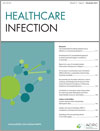
Healthcare Infection
Volume 17 Number 4 2012
HI12019Can homemade fit testing solutions be as effective as commercial products?
National guidelines recommend that healthcare workers (HCW) who use N95 masks require fit testing. The aim of this study was to determine how a homemade fit testing solution compared against a commercially available product and a placebo. The findings of our study suggest that fit testing solutions could be made locally with a similar effect to that of commercial products.
HI12022Development of a standardised approach to observing hand hygiene compliance in Australia
This is the first time the methodology of a national standardised hand hygiene compliance (HHC) auditing program has been described in detail. This paper provides clear instruction on HHC auditing requirements and illustrates the efforts required to implement a uniform national program. The HHA 5 Moments for Hand Hygiene observation method has allowed the accurate, reliable and meaningful collection of HHC data that is driving HHC improvement in Australia
HI12024Report of a case of neonatal malaria (Plasmodium falciparum) in Nigeria
Neonatal malaria has been considered to be rare even in malaria-endemic areas and this assumption has led to a significant proportion of neonates with malaria being missed or wrongly diagnosed. A case is reported of a 15-day-old female with Plasmodium falciparum malaria in Lagos, Nigeria. As non-endemic countries such as Australia continue to receive a high number of immigrants from neighbouring and distant malaria endemic regions, it is imperative to consider this condition in babies of mothers who have recently travelled to or emigrated from a malaria-endemic region.
HI12029An increase in community onset Clostridium difficile infection: a population-based study, Tasmania, Australia
There have been recent reports of increases in Clostridium difficile infection (CDI) in Australia. We undertook a population based study to examine this phenomenon further and found that recent increases in Tasmania were driven by community associated CDI. A further understanding of CDI transmission pathways in the community is needed.
HI12048Key priorities for Australian infection control: summary of findings from the launch of the Centre for Research Excellence in Reducing Healthcare Associated Infections
The launch of the Centre of Research Excellence in Reducing Healthcare Associated Infection took place on 12 October 2012. An important part of this event was a Consultation Workshop, at which experts in the Australian infection control community came together to establish the research and clinical priorities in Australian infection control, assess the importance of various multi-resistant organisms, and to gather information about decision making in infection control. We present here a summary of the responses received.
HI12035Centrelink: an innovative urban intervention for improving adult Aboriginal and Torres Strait Islander access to vaccination
This case study examined the potential for improving vaccination rates among Aboriginal and Torres Strait Islander peoples in urban areas. A vaccination clinic was established in Townsville, Qld at Centrelink, an Australian Government statutory agency, which delivers a range of payments and human services. This clinic delivered an increasing number of vaccinations per year and may be an effective strategy for improving vaccination rates in other areas.

